Home
> Scales
> Lydian Dominant
Not a lot of musicians realise that the lydian dominant scale is one of the most reliable scales when it comes to soloing over particular chord types. If you find yourself in a musical no-mans-land, this scale really can save your solo. Not only that, it's also easy to make something beautiful from this scale (unlike many other scales where you have to work harder to extract the real juice).
So, let's explore the wonderful (sometimes weird) world of lydian dominant, starting with a short presentation and then moving on to the supplemental content...
We also know the key intervals that define the scale (aside from the major triad) are the augmented 4th (#4) and minor 7th (b7).

Translated to the fretboard, it looks something like this, starting with the E string root pattern...
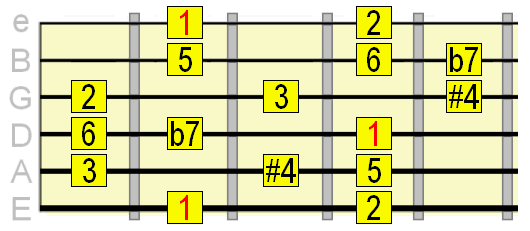
Or, with an A string root (also known as the scale's 5th position pattern), which you could use to visualize the scale around an A form chord...
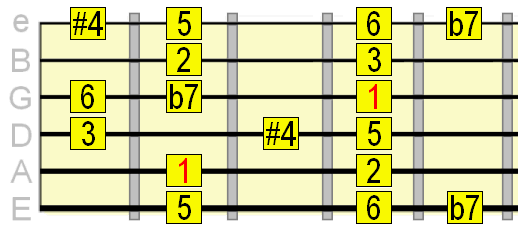
The important thing at this stage is that you explore how the intervals of the scale interact and harmonize with its related backing chord. Have fun with it. Go nuts!
Specifically, try holding that #4 over the chord (or targeting it in a simple phrase), close your eyes and really feel it. Get to know the scale as intimately as you can, that way you won't have to think about when to use it - you'll hear it shout "play me!" in your head at the right moments.
With these tracks, make sure you align the root note (1) of whichever pattern you use to the root of the chord.
 C7 chord track - C
Lydian Dominant -
download here (right click "save
as")
C7 chord track - C
Lydian Dominant -
download here (right click "save
as")
 A7 chord track - A
Lydian Dominant
- download here
A7 chord track - A
Lydian Dominant
- download here
In the video, I gave three main examples of the kind of chord changes that lydian dominant works well over. I'll tab out these example licks below, but now it's your turn to try out the changes!
However, lydian dominant makes a nice change and helps to enhance that V chord tension before the resolution back to the tonic.
So, when V leads to I in the progression (a very common movement), try switching to lydian dominant over that V chord, and then back to the major scale over the I. Use the table and tracks below to practice this V - I transition (note: fret positions are labelled beneath the diagrams)...
 Cmaj / G7 - download here
Cmaj / G7 - download here
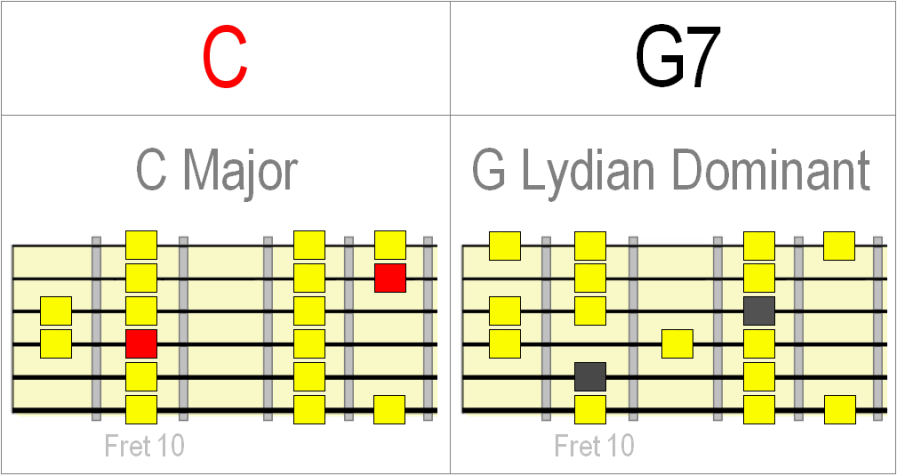
Tip: As you learn more patterns and positions for your scales, you'll get better at moving between scales. For now though, just keep the patterns as overlapped as you can (i.e. at the same fret) to keep things simple. So that's why in the above diagram I'm using C major's 2nd position pattern, because it overlaps nicely with the G lydian dominant pattern in the same position (10th fret).
Now in a different key - Eb major. So this time Bb7 will be the V chord and therefore lydian dominant's root will be... that's right, Bb!
 Ebmaj / Bb7 - download here
Ebmaj / Bb7 - download here
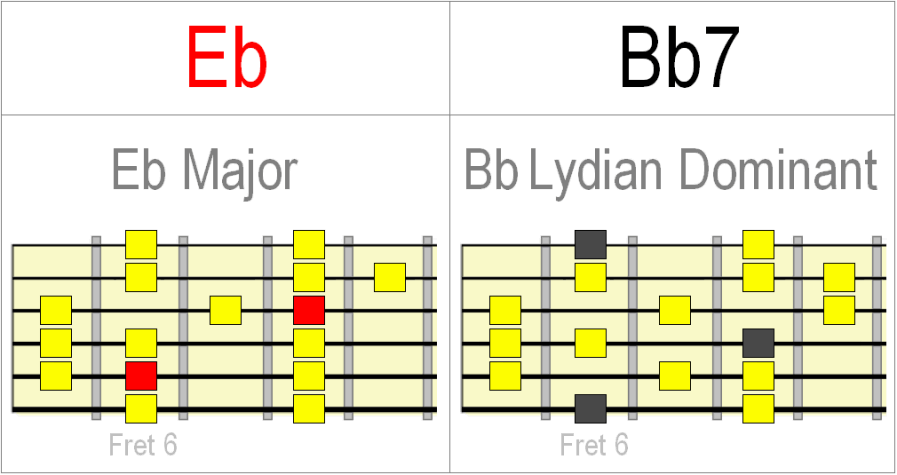
Moving on... exactly the same concept as before (V - I) but this time there's a third chord, Dm (ii). The sequence is Dm / G7 / Cmaj. So we use C major over Dm, switch to G Lydian dominant over G7 and then back to C major over Cmaj. The root notes for each chord are color marked on the diagrams to help you keep your bearings as the chord changes.
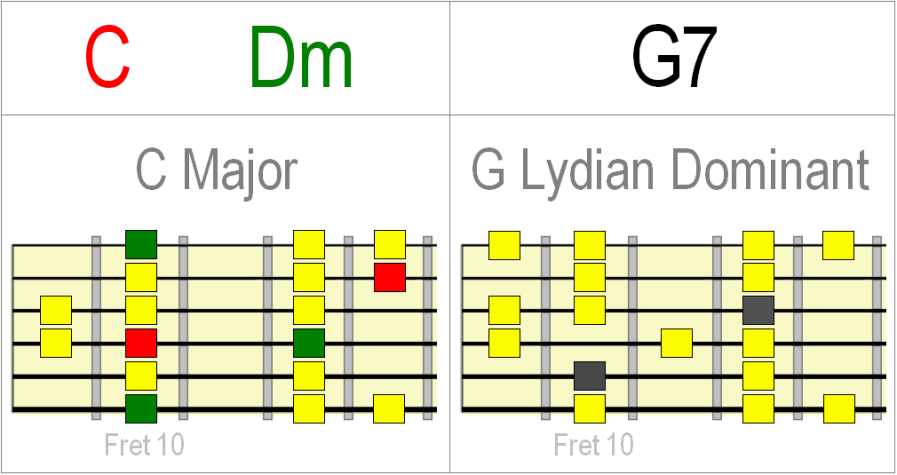
Let's hear an example of this switch in action (don't worry, the backing track you'll download in a moment is a lot slower than the example track!). Click the tab to hear.
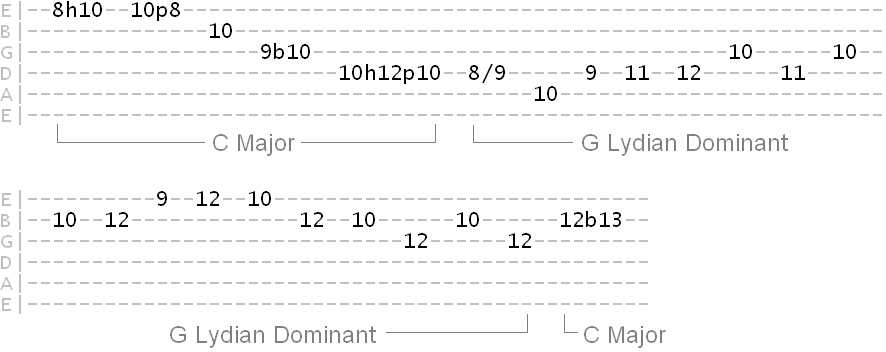
Download the backing track and use the diagrams above to try your own...
 Dm / G7 / Cmaj - download here
Dm / G7 / Cmaj - download here
This means even if there's a movement to a dom7 chord outside the original key/scale (e.g. a substituted chord), lydian dominant will be a safe and effective scale choice over that chord.
If before you were struggling with choosing scales/notes outside the natural major/minor keys, lydian dominant will have you covered for most instances of a dom7 chord and many instances of a major triad.
First example - what is known as a back door progression involving a VII subtonic chord. This chord is not part of major scale harmony. In relation to the tonic of B major, that back door chord is A7 and this is where we change from B major to A lydian dominant.
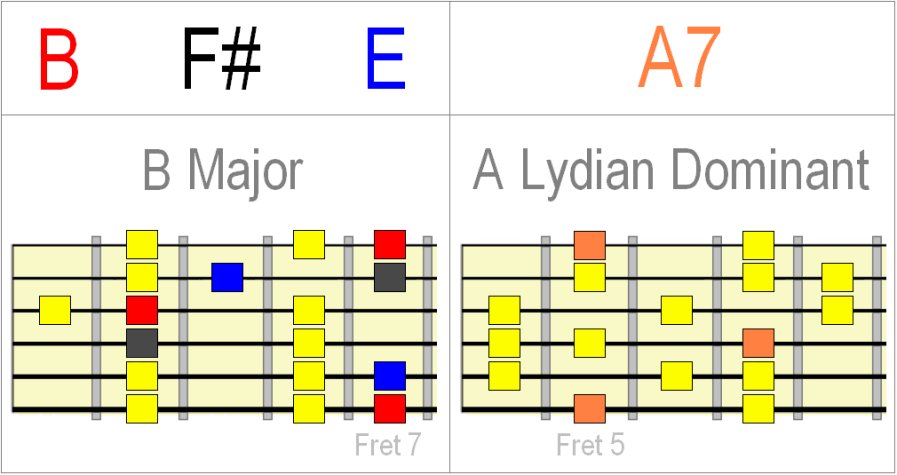
Here's my (very basic) example (click tab to hear)...
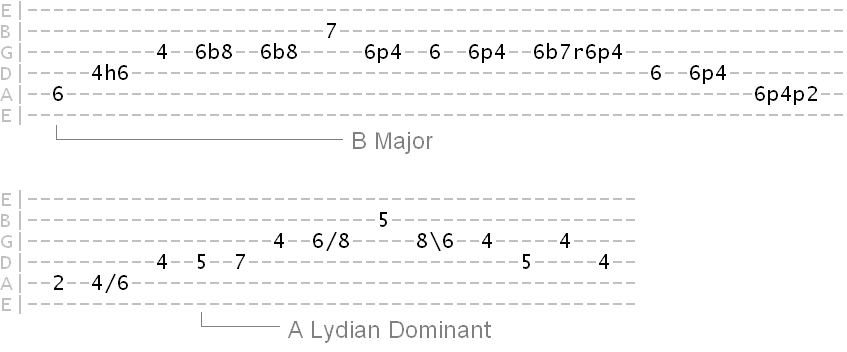
 Bmaj / F#maj / Emaj / A7 - download here
Bmaj / F#maj / Emaj / A7 - download here
Finally, another example of how lydian dominant can be used over those rebellious dominant 7th chords outside the V position.
This time, in the key of D major, the dom7 occupies the bVI degree as a V substitute - Bb7 (don't worry about altered chord degrees for now!).
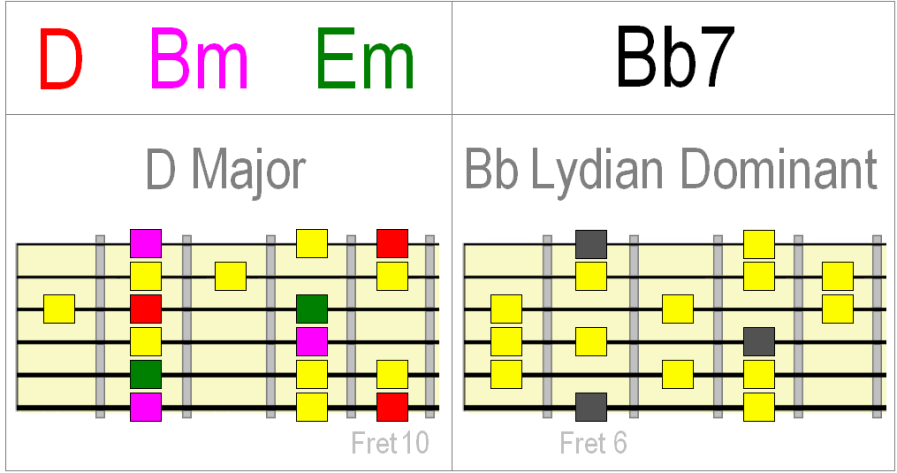
My humble attempt (click tab to hear)...

 Dmaj / Bm / Em / Bb7 - download here
Dmaj / Bm / Em / Bb7 - download here
In short, whenever a progression changes to a dom7 chord and it doesn't fit into the original major key, lydian dominant is your most reliable choice. Plus, it sounds great!
There are so many more examples I'd love to give you, including minor key progressions, where exactly the same principle applies - outside dominant 7th chord = lydian dominant.
But I hope you get the idea. Happy soloing and please feel free to comment below with any questions. Thanks for your time and patience.
Share your thoughts...
Have any questions, thoughts or ideas about this lesson? Let us know using the comments form below.
The Lydian Dominant Scale - Dare to Venture "Outside"
While the natural major and minor scales (including their pentatonic variations) are often all we need to create meaningful solos and phrases, there'll come a time when a chord change will throw you outside of that diatonic comfort zone.Not a lot of musicians realise that the lydian dominant scale is one of the most reliable scales when it comes to soloing over particular chord types. If you find yourself in a musical no-mans-land, this scale really can save your solo. Not only that, it's also easy to make something beautiful from this scale (unlike many other scales where you have to work harder to extract the real juice).
So, let's explore the wonderful (sometimes weird) world of lydian dominant, starting with a short presentation and then moving on to the supplemental content...
Basic Lydian Dominant Scale Theory
So, from the video we know that lydian dominant works over dominant 7th chords with the same root (e.g. C lydian dominant over C7, E lyd dom over E7 etc.).We also know the key intervals that define the scale (aside from the major triad) are the augmented 4th (#4) and minor 7th (b7).

Translated to the fretboard, it looks something like this, starting with the E string root pattern...

Or, with an A string root (also known as the scale's 5th position pattern), which you could use to visualize the scale around an A form chord...

For those who already know the melodic minor scale...
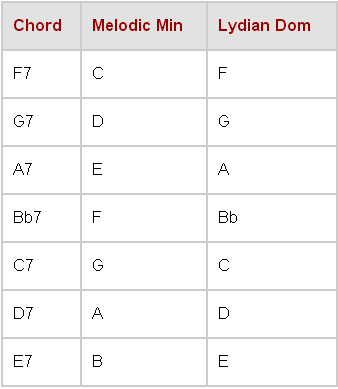 As lydian dominant is the 4th
mode of melodic minor, and if you find it easier to
visualize this way, you can simply play any melodic minor pattern you
know, but position its 4th note
on the root of the chord you're playing over.
As lydian dominant is the 4th
mode of melodic minor, and if you find it easier to
visualize this way, you can simply play any melodic minor pattern you
know, but position its 4th note
on the root of the chord you're playing over.
Use the table on the right to see which root you'd position the melodic minor pattern on to get the right lydian dominant root. So, for example, if the chord was A7, you could play E melodic minor and it will sound like A lydian dominant!
 As lydian dominant is the 4th
mode of melodic minor, and if you find it easier to
visualize this way, you can simply play any melodic minor pattern you
know, but position its 4th note
on the root of the chord you're playing over.
As lydian dominant is the 4th
mode of melodic minor, and if you find it easier to
visualize this way, you can simply play any melodic minor pattern you
know, but position its 4th note
on the root of the chord you're playing over.Use the table on the right to see which root you'd position the melodic minor pattern on to get the right lydian dominant root. So, for example, if the chord was A7, you could play E melodic minor and it will sound like A lydian dominant!
Backing Tracks & Ear Training
OK, let's get a feel for the scale by playing over some "drone tracks". These are backing tracks that hold a chord continuously, with no beat, allowing you to set your metronome (or drum machine) at the tempo you feel comfortable.The important thing at this stage is that you explore how the intervals of the scale interact and harmonize with its related backing chord. Have fun with it. Go nuts!
Specifically, try holding that #4 over the chord (or targeting it in a simple phrase), close your eyes and really feel it. Get to know the scale as intimately as you can, that way you won't have to think about when to use it - you'll hear it shout "play me!" in your head at the right moments.
With these tracks, make sure you align the root note (1) of whichever pattern you use to the root of the chord.
 C7 chord track - C
Lydian Dominant -
download here (right click "save
as")
C7 chord track - C
Lydian Dominant -
download here (right click "save
as") A7 chord track - A
Lydian Dominant
- download here
A7 chord track - A
Lydian Dominant
- download herePlaying Lydian Dominant Through Chord Changes
Once you're comfortable with playing the scale over single chords, the next logical step is to get confident with switching to lydian dominant at the right moment in a chord progression.In the video, I gave three main examples of the kind of chord changes that lydian dominant works well over. I'll tab out these example licks below, but now it's your turn to try out the changes!
Over the 5 chord
Usually, when using the major scale of the key you're playing in, the V (5) chord will be covered by the scale. For example, in the progression Dm / G7 / Cmaj (ii / V / I) the C major scale will work through all three chords.However, lydian dominant makes a nice change and helps to enhance that V chord tension before the resolution back to the tonic.
| Not
entirely sure what these numerals (I, IV, V etc.) mean on
the fretboard? I highly recommend Jonathan Boettcher's crash course in guitar theory. |
So, when V leads to I in the progression (a very common movement), try switching to lydian dominant over that V chord, and then back to the major scale over the I. Use the table and tracks below to practice this V - I transition (note: fret positions are labelled beneath the diagrams)...
 Cmaj / G7 - download here
Cmaj / G7 - download here
Tip: As you learn more patterns and positions for your scales, you'll get better at moving between scales. For now though, just keep the patterns as overlapped as you can (i.e. at the same fret) to keep things simple. So that's why in the above diagram I'm using C major's 2nd position pattern, because it overlaps nicely with the G lydian dominant pattern in the same position (10th fret).
Now in a different key - Eb major. So this time Bb7 will be the V chord and therefore lydian dominant's root will be... that's right, Bb!
 Ebmaj / Bb7 - download here
Ebmaj / Bb7 - download here
Moving on... exactly the same concept as before (V - I) but this time there's a third chord, Dm (ii). The sequence is Dm / G7 / Cmaj. So we use C major over Dm, switch to G Lydian dominant over G7 and then back to C major over Cmaj. The root notes for each chord are color marked on the diagrams to help you keep your bearings as the chord changes.

Let's hear an example of this switch in action (don't worry, the backing track you'll download in a moment is a lot slower than the example track!). Click the tab to hear.

Download the backing track and use the diagrams above to try your own...
 Dm / G7 / Cmaj - download here
Dm / G7 / Cmaj - download here"Outside" dominant 7th chords
This is where the main benefit of knowing lydian dominant truly reveals itself. It's flexible enough to work over pretty much any instance of a dominant 7th chord.This means even if there's a movement to a dom7 chord outside the original key/scale (e.g. a substituted chord), lydian dominant will be a safe and effective scale choice over that chord.
If before you were struggling with choosing scales/notes outside the natural major/minor keys, lydian dominant will have you covered for most instances of a dom7 chord and many instances of a major triad.
First example - what is known as a back door progression involving a VII subtonic chord. This chord is not part of major scale harmony. In relation to the tonic of B major, that back door chord is A7 and this is where we change from B major to A lydian dominant.

Here's my (very basic) example (click tab to hear)...

 Bmaj / F#maj / Emaj / A7 - download here
Bmaj / F#maj / Emaj / A7 - download hereFinally, another example of how lydian dominant can be used over those rebellious dominant 7th chords outside the V position.
This time, in the key of D major, the dom7 occupies the bVI degree as a V substitute - Bb7 (don't worry about altered chord degrees for now!).

My humble attempt (click tab to hear)...

 Dmaj / Bm / Em / Bb7 - download here
Dmaj / Bm / Em / Bb7 - download hereIn short, whenever a progression changes to a dom7 chord and it doesn't fit into the original major key, lydian dominant is your most reliable choice. Plus, it sounds great!
There are so many more examples I'd love to give you, including minor key progressions, where exactly the same principle applies - outside dominant 7th chord = lydian dominant.
But I hope you get the idea. Happy soloing and please feel free to comment below with any questions. Thanks for your time and patience.
| Was this
helpful? Please support this site. I really appreciate it! |
Stay updated
and learn more Sign up to the newsletter for updates and grab your free Uncommon Chords book |
Share your thoughts...
Have any questions, thoughts or ideas about this lesson? Let us know using the comments form below.








